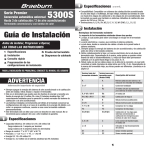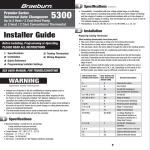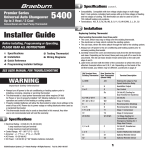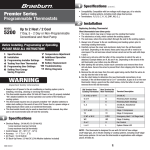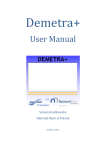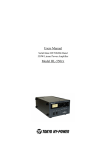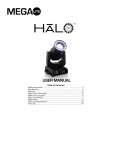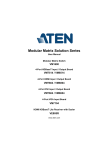Download Braeburn 5300 Specifications
Transcript
1 Specifications cont. Premier Series Universal Auto Changeover Up to 2 Heat / 2 Cool 5300 Conventional and Heat Pump Thermostat Installer Guide Before Installing, Programming or Operating, PLEASE READ ALL INSTRUCTIONS 1 Specifications 5 Testing Thermostat 2 Installation 6 Wiring Diagrams 3 Quick Reference 4 Programming Installer Settings SEE USER MANUAL FOR TROUBLESHOOTING WARNING Important Safety Information • Always turn off power to the air conditioning or heating system prior to installing, removing, cleaning or servicing thermostat. • This thermostat is a dual power thermostat and either requires 24 Volt AC Power or two (2) properly installed “AA” Alkaline batteries for normal operation and control of the heating or cooling system. • Properly installed batteries will allow the thermostat to retain clock settings in the event of loss of AC Power due to power outage or rolling blackouts when used as a hardwired thermostat. • This thermostat should only be used as described in this manual. Any other use is not recommended and will void the warranty. 1 Specifications • Electrical Rating: 24 Volt AC (18-30 Volt AC) 1 amp maximum load per terminal 3 amp maximum load (all terminals) • Control Range: 45º - 90º F (7º C - 32º C) • Accuracy: +/- 1º F (+/- .5º C) • AC Power: 18-30 Volt AC • DC Power: 3.0 Volt DC (2 “AA” Alkaline batteries included) © 2006 Braeburn Systems LLC • Patents Pending • All Rights Reserved. Pub. No. 5300-100-003 • Compatibility: Compatible with low voltage single stage or multi-stage heat/cool systems, including heat pumps with up to two stages of heating and two stages of cooling. This thermostat can also be used on 250mv to 750mv millivolt heating only systems. • Terminations: R, Rc, O, W1/E, B, Y2, W2, Y1, G, C, L, S1, S2 2 Installation Replacing Existing Thermostat Most existing thermostats have three parts: • The cover, which may snap or hinge over the existing thermostat. • The electronics or body, which controls the existing system. • The sub-base, where the wires attach through the wall to the existing system. 1. Always turn off power to the air conditioning and heating system prior to removing existing thermostat. 2. Carefully remove the cover and electronics body from the old thermostat sub-base. Depending on the brand, these parts may pull off or need to be unscrewed. The old sub-base should remain wired and on the wall until steps 4 and 5. 3. Label every old wire with the letter of the connection to which the wire is attached. Example letters are R, M, Y, etc. Depending on the brand of the old thermostat, your letters may be different. 4. After labeling the old wires, loosen each connection and remove them from old sub-base. Secure the wires to prevent them from slipping into the opening in the wall. 5. Remove the old sub-base from the wall, again being careful that the wires do not slip into the opening in the wall. 6. Use the chart below to determine the new thermostat connections. As an example, if the old thermostat had a G or F connection, it goes to G on the new thermostat. It may be helpful to use the chart by circling (with a pencil or pen) the letter of each wire removed from the old thermostat. NOTE: This thermostat is designed for use on low voltage 24 volt AC single stage or multi-stage systems, including heat pumps with up to two stages of heating and two stages of cooling. Do not use this thermostat on systems with voltage higher than 30 Volts AC. This thermostat requires a transformer common wire for proper installation if used as a hardwired thermostat. Old Terminal from Existing Thermostat R, V-VR or VR-R O or R E/W1 B Y2 W1, W2 or W-U Y, Y1 or M G or F C, X or B L or X S1 S2 New Terminal for New Thermostat R Rc Terminal Description 24 Volt AC 24 Volt AC (Cooling for Dual Transformer Systems) Reversing Valve (Cooling) 1st Stage Heating for Conventional Systems or Emergency Heating for 2 Stage Heat Pumps Reversing Valve (Heating) Stage 2 Compressor Stage 2 Heating Stage 1 Compressor Fan Control 24 Volt AC, Transformer Common System Monitor Optional Remote Sensor Optional Remote Sensor O E/W1 B Y2 W2 Y1 G C L S1 S2 1 2 Installation cont. 3 Quick Reference Installing New Thermostat Inside of model 5300 shown NOTE: When installing this thermostat in a new location, following a few simple guidelines and the applicable building codes will give the best results. Install the thermostat in a location that provides good airflow by avoiding areas behind doors, near corners, air vents, direct sunlight or heat generating devices. The wiring must conform to all building codes and ordinances as required by local and national code authorities having jurisdiction for this installation. 1. Always turn off the power to the air conditioning and heating system prior to installing this thermostat. 2. Locate the release latch on the bottom (not the back) of the thermostat. Press the release latch in and separate the body from the sub-base of the thermostat. 3. Set the thermostat electronics and cover down on a clean surface. Place the sub-base on the wall in the desired location. 4. Using the slotted mounting holes in the sub-base, mark the placement of the mounting holes through the slots and onto the wall. Ensure the wires come out of the wall into the center hole of the sub-base. 5. After verifying the drill will not damage items in the wall, use a 3/16 drill to create the mounting holes. Gently tap the supplied plastic anchors into the holes in the wall. 6. Place the thermostat sub-base against the wall in the desired location. Ensure the thermostat is level, the wires are inserted in the opening, and the mounting holes are aligned with the slots on the sub-base. 7. Fasten sub-base to wall using supplied screws into the plastic wall anchors. 8. Connect wires to the quick wiring terminal blocks. Use the wiring diagram chart to ensure the old and new connections are correct. 9. To prevent electrical shorts and potential damage to the thermostat, make sure all wire connections are secure and not touching each other. 10. Locate the thermostat body, and ensure the cover is still installed properly. Using the mounting tabs on the top of the sub-base as a guide or hinge, close up the thermostat case by pivoting the body and cover closed. The latch on the bottom of the thermostat will click when the case is properly closed. 11. Flip the front thermostat cover up and open the battery compartment door. 12. Locate the positive [+] ends of the batteries and match them with the positive [+] terminals located in the battery compartment. Install the two new “AA” alkaline batteries (supplied). Close battery compartment door. 13. Restore system power and proceed to programming and system checkout. 2 8 10 9 7 1 6 2 3 4 5 SYSTEM Button: Selects AUTO (Heat/Cool), COOL, OFF, HEAT or EMER. PROG Button: Program setup mode, selects set point time, temperature and fan setting for each program. 3 HOLD Button: Enables extended hold, clears extended hold or temporary override. 4 RETURN Button: Scrolls between installer setup screens, or returns unit to the normal mode from program mode. 5 DAY/TIME Button: Selects hour, minute and day setting. Selects program day in program setting mode. 6 FAN Button: Selects AUTO, ON, CIRC (recirculate) and PROG (program) modes. 7 RESET Button: Located on front of thermostat, will return programming, clock, differential settings, filter check monitor, adjustment limit from set point, keypad lock, temperature hold, short cycle timer and recirculating fan to default settings if previously programmed. 8 Button: Turns on backlight for 10 seconds. 9 Button: Increases setting (time, temperature, etc.). Scrolls between option settings. 10 Button: Decreases setting (time, temperature, etc.). Scrolls between option settings. 4 + 2 RETURN and PROG Buttons: When pressed at the same time, returns unit to the normal mode from Installer setup option mode. 4 + 9 RETURN and Buttons: Installer setup option mode is entered when holding the RETURN and buttons together for 3 seconds. CLEAR Button: Located on back side of circuit board, resets thermostat to all factory defaults. 1 2 3 4 Programming Installer Settings Default Thermostat Settings At initial power up or after Installer CLEAR is pressed, the thermostat is reset to factory defaults. Installer CLEAR is located on the circuit board. Function Status after Clear Operation mode Temperature hold Fan Switch Clock Room temperature display OFF, Auto Changeover enabled Permanent and temporary hold cleared AUTO 12:00 pm, Monday 70° F (21.0° C), to be renewed within 5 seconds Set point temperature 62° F (17.0° C) for Heat, Emergency Heat and Off 83° F (28.0° C) for Cool Temperature scale Fahrenheit Operating program DAY program, Monday Low-battery warning Off, to be renewed within 5 seconds AC interrupted warning Off, to be renewed within 5 seconds 1st stage differential .5° F (0.2° C) 2nd stage differential 2° F (1.0° C) Programming 7 Day, 4 Event Deadband 3° F Residual Cooling Fan Delay 60 seconds Short cycle protection timer On, 5 minutes, Reset Adaptive Recovery Mode ON Output relays All turned off Recirculating Fan Timer reset, with 24 min OFF, 12 min ON, Lock OFF Extended Hold Long (indefinite) Filter Check Monitor 0 days-No Warning, Timer reset Keypad Lock Complete (level 2), unlocked, 555 universal code System type Conventional, Single Stage 1st Stage Heat Fan Control Gas 2nd Stage Heat Fan Control Electric Fossil Fuel Compressor Lock Off Auto Changeover Enabled Compressor Outage Protection Off, Timer reset Temperature Sensor Internal 12 / 24 Hour Clock 12 hour Adjustment Limit from Set point 0, OFF AC Interrupt Warning Mode OFF User Profile Residential 4 Programming Installer Settings cont. When the User RESET button (on front of thermostat) is pressed, the following options will reset to the factory defaults. All other settings are saved when the RESET button is pressed. Function Status after Reset Programming Default setting depending on programming mode setting (see User Manual). For manual mode: Heat - 62° F, Cool - 83° F. 12:00 pm, Monday .5° F (0.2° C) 2° F (1.0° C) Clock 1st stage differential 2nd stage differential (if configured for Multi-Stage) Filter Check Monitor Adjustment Limit from Set point Keypad Lock Temperature Hold Short Cycle Timer Recirculating Fan 0 days-No Warning 0, OFF 555 universal code or last code entered Permanent and temporary hold cleared, reset to Long Hold Reset Timer reset, 24 minute off cycle. With recirculating lock set, fan state defaults to CIRC. Setting Thermostat Installer Options The Installer Options section allows the system and programming parameters to be set up at installation. The Installer Options mode is menu driven. As the different options are programmed you may eliminate specific options. For example, if the system is set to single stage heat pump, Option 8, selecting the first stage fan control will no longer be available. The Installer Option mode is entered by holding the RETURN and buttons together for 3 seconds. Installer Option 1 Residential or Commercial will be displayed. Pressing the or buttons will scroll between choices. To scroll to the next installer option, press the RETURN button. The thermostat will return to normal operating mode after the last Installer Option mode has been set or by pressing the RETURN and PROG buttons at the same time. NOTE: The thermostat will return to normal operating mode automatically after 30 seconds if no key is pressed. NOTE: Any changes to Installer Option 7 (System Type) will cause Options 8, 9, 10, 11 and 12 to reset to the default values that are dependent on system selection. 4 5 4 Programming Installer Settings cont. Installer Options 1 – Residential or Commercial 2 – Programming Mode 3 – 12/24 Clock Factory Default Options aes aes, bus pao67 12h 4 – Temperature Scale de6F 5 – Auto Changeover autoON 6 – Dead Band band 3 7 – System Type 11C 8 – First Stage Fan Control 1H6 9 – Second Stage Fan Control 2HE 10 – Fossil Fuel Backup Option auh AE 11 – AC Power off-AC Interrupt Warning 12 – Compressor Power Outage Protection cpopOFf 13 – Short Cycle Protection cscp 5 14 – Residual Cooling Fan Off Delay fan60 15 – Recirculating Fan ciacOFf Lock 16 – Enable / Disable aec ON ARM™ 17 – Set Sensor Control sens1 18 – Set Security Level sec 2 for Keypad Lock Comment Selects a Residential or Commercial (BUS) profile. pao67, Not available if thermostat pao6 52, is in the Commercial pao6NO (BUS) profile. 12h, 24h Selects either 12 hour or 24 hour clock. de6F, de6C Selects either Fahrenheit or Celsius. autoON, Either enables or disables autoOFf Auto Changeover. band 2, band 3, Selects Auto Changeover band 4, Dead Band of 2, 3, 4 or 5º F band 5 (1.5, 2.0, 3.0º C), if Auto Changeover is enabled. 11C, 22C, Selects single stage 11HP, 22HP conventional, 2 stage conventional, single stage heat pump, or 2 stage heat pump. 1HG, 1HE Not available with a heat pump system. Selects between 1st stage gas or electric heat. 2HE, 2H6 Only available with a 2nd stage heat pump system. Selects between 2nd stage gas or electric heat. auh AE, Only available with a 2nd stage auh A6 heat pump system. Locks out 1st stage during 2nd stage heat call for fossil fuel backup systems (AUXAG). With an electric backup system (AUXAE) both stages will run. off-AC, Only available when thermostat is on-AC installed as a hardwired unit. Select between turning the AC power interrupt warning off or on. cpopOFf, Only available with 2nd stage heat cpopON pump and AC power connected. Select between compressor lock off and compressor lock on. cscp 5, cscp 4, Selects 5, 4, 3, 2 or 0 cscp 3, cscp 2, minutes for the compressor cscp 0 short cycle protection. fan00, Selects 0, 30, 60 or 90 seconds as fan30, the time the fan will stay on after fan60, the cooling system has satisfied fan90 the set point temperature and has turned off the compressor. ciacOFf, Selects between Recirculating ciacON Fan Lock off or on. aec ON, Enables or disables ARM™. aec OFf, Not available in nonprogrammable mode. sens1, Selects between Internal, sensE, External and Averaging sensor sensA control. This is only available if the remote sensor is connected. sec 1, Selects between level 1 or level sec 2 2 keypad lockout. 6 4 Programming Installer Settings cont. 1. Selects Residential or Commercial (BUS) profile. Determines programming events per day. If Residential is selected, 4 events per day are available. If Commercial is selected, 2 events per day are available. Only the 7 day programmable mode is available for the Commercial profile. 2. Selects the programming mode, either full 7 day or 5-2 day (weekdayweekend) programming or non-programmable. If the Commercial profile was selected in step 1 this option is not available. 3. Selects either a 12 hour or 24 hour clock. 4. Selects preferred temperature scale of either ºF or ºC. 5. Selects either Auto Changeover on or off. When off is selected, the AUTO icon will not be displayed when selecting the system options with the system switch. When Auto Changeover mode is enabled and selected, the system automatically switches between heating and cooling when the room temperature meets the programmed heating or cooling set points. 6. When Auto Changeover mode is enabled and selected, the system automatically switches between heating and cooling when the room temperature meets the normal criteria for either a heating or cooling call. There is a forced separation (dead band) between the heating and cooling set points, so the systems do not work against each other. This option selects Auto Changeover Dead Band of 3, 4 or 5º F (1.5, 2.0, 3.0º C) the default is 3º F. 7. Selects single stage conventional (11C), 2 stage conventional (22C), single stage heat pump (11HP), or 2 stage heat pump (22HP). Any change made to the system type resets Installer Options 8 through 12 to their default values dependent on system selected. 8. Selects between 1st stage gas or electric heat. This Installer Option is not available with a heat pump system. 9. Selects between 2nd stage gas or electric heat. This Installer Option is only available with a 2 stage heat pump system. 10. For heat pump units with an electric auxiliary stage, both the first and second stages of heating will run when a call for second stage heat is made. For heat pump units with a fossil fuel auxiliary stage, the first stage will be locked out one minute after a second stage heat call, and the second stage will only be used. 11. Select between turning the AC power interrupt warning off or on. During a power loss, the thermostat will display an outage warning. The system clock will continue to run, and all settings will be maintained until the outage period is over. This Installer Option is only available when thermostat is installed as a hardwired unit. 12. This thermostat provides cold weather compressor protection by locking out the compressor stage (1st stage) of heating for a period of time after a power outage greater than 60 minutes. The lockout period is one hour less than the outage time, up to a maximum of 12 hours. During that period of time, the auxiliary heat stage will still be available to maintain the set point temperature. The compressor lockout can be disabled by setting this option to OFF. 13. This thermostat includes an automatic compressor protection feature to avoid potential damage to the cooling system from short cycling. This thermostat automatically provides an adjustable delay after turning off the cooling system output to protect the compressor. This protection is also present in the heat mode of operation on single stage heat pump systems to protect the compressor. (continued on page 8) 7 4 Programming Installer Settings cont. 14. During the COOL mode of normal operation the fan will stay on for 60 seconds after the cooling system has satisfied the set point temperature and has turned off the compressor. This allows the system to provide higher efficiency during cooling operation. 15. The Recirculating Fan can be “locked on”, so that the only fan selections available to the user are CIRC and ON. The Recirculating Fan Mode provides more even temperature distribution and improves indoor air quality by circulating air through the furnace filtration system more often. By locking the Recirculating Fan on, the user will only have the option to run the fan all the time (ON) or use the Recirculating Fan Feature (CIRC). If the Recirculating Fan lock is not set to on, the thermostat is put into the Recirculating Fan Mode by pressing the FAN button until the CIRC icon is displayed. If no call for heating or cooling occurs within the fan off cycle set in the User Options (see User Manual), the fan will run for 12 minutes. The highest setting, 120 minutes, will run the fan least often – 9% minimum running time. The lowest setting, 24 minutes (factory default), will run the fan most often – 33% minimum running time. The Recirculating Fan feature is available in the COOL, OFF, HEAT, or EMER mode. 16. Enables or disables the ARM™ feature. During ARM™, room temperature is recovered gradually by turning on the heating or cooling before the end of the set back period. In a multi-stage configuration, room temperature is recovered gradually by using only the first stage heating or cooling until the last 20 minutes, to minimize the use of the 2nd stage heating or cooling. The set point temperature is changed to that of the upcoming comfort program temperature. ARM™ does not operate when the unit is in the temporary or permanent HOLD mode if the program is temporarily overridden or if emergency heat is selected for multi-stage heat pumps. If the ARM™ feature is disabled the thermostat will recover the set point temperature at the programmed set point time after the setback period ends. 17. If the remote sensor is connected during installation, you must select between internal, external and averaging remote sensor control. 18. The keypad lockout feature has two levels of security. Level one locks all buttons (including the reset) except for the , and backlight buttons. Level 2 locks the entire keypad except the backlight button. The and buttons can be pressed together to enter the lock code but the buttons do not work individually to adjust the temperature. The lock level is set during the Installer Options and the lock code is set in the User Options. See the User Manual, Section 2. NOTE: Any changes to Installer Options 1 through 6 will cause all User Options and Programming to reset to their default values if the User Options were previously programmed. See User Manual, Section 2. 8 5 Testing the Thermostat WARNING! Read BEFORE Testing • Do not short (or jumper) across terminals on the gas valve or at the heating or cooling system control board to test the thermostat installation. This could damage the thermostat and void the warranty. • Do not select the COOL mode of operation if the outside temperature is below 50º F (10º C). This could possibly damage the controlled cooling system and may cause personal injury. • This thermostat includes an automatic compressor protection feature to avoid potential damage to the cooling system from short cycling. The default is to provide a 5-minute delay after turning off the cooling or heating output to protect the compressor. This default can be changed in Section 4, Programming Installer Options. NOTE: Test your thermostat prior to programming any user settings. Pressing the Installer CLEAR button will reset the thermostat to all factory defaults. Pressing the User RESET button will erase programming, clock, differential settings, filter check monitor, adjustment limit from set point, keypad lock, temperature hold, short cycle timer and recirculating fan if previously programmed. This will return all User Options to their default values. 1. Scroll through system settings on the left side of the display to HEAT. 2. Press the button on the keypad until the set point temperature setting is a minimum of 3 degrees higher than the current room temperature. The heating system should start within several seconds. The fan may not turn on immediately due to the heating system built-in fan delay. 3. Scroll through system settings to OFF. The heating system should stop within several seconds. 4. Scroll through system settings to COOL. 5. If the compressor has previously been running, then you must wait 5 minutes, or until the installer programmed delay set in Section 4, Option 13, for the automatic compressor short cycle protection period to expire. You can also press the RESET button to bypass this feature for initial testing purposes. Pressing the RESET button will erase programming, clock, differential settings, filter check monitor, adjustment limit from set point, keypad lock, temperature hold, short cycle timer and recirculating fan if previously programmed. This will return all user options to their default values. 6. Press the button on the keypad until the set point temperature is a minimum of 3 degrees lower than the current room temperature. 7. The cooling system should start within several seconds. Scroll through system settings to OFF. The cooling system should stop within 90 seconds (dependent on the setting of the Residual Cooling Fan Feature). 8. Scroll the fan settings to ON, the system blower should start. 9. Scroll the fan settings to AUTO, the system blower should stop. 9 6 Wiring Diagrams Heat Pump Systems (See Note 5) R RC O W1 / E B W2 2nd Stage Compressor Control (Note 2) Emergency Heat Control (See note 4) Reversing Valve (Active in Cooling-See Note 3) Y2 Reversing Valve (Active in Heating-See Note 3) Y1 G 1st Stage Compressor Control 2nd Stage Heat Control (Note 2) C L S1 S2 NOTES: 1. Transformer Common connection not required for battery-only operation of thermostat. 2. Second Stage Control connections not used for single stage heating or cooling systems. 3. For units requiring reversing valve to be energized during heating, connect reversing valve to B terminal. For units requiring reversing valve to be energized during cooling, connect reversing valve to O terminal. 4. Required for units with 2 stage heat only. 5. For 2 stage heat units not having a separate Emergency Heat Terminal, add installer supplied jumper. NOTES: 1. Transformer Common connection not required for battery-only operation of thermostat. 2. Second Stage Control connections not used for single stage heating or cooling systems. 3. For millivolt or other 2-wire heating systems, connect 2 wires from heating control to R and W1. NOTES: 1. Transformer Common connection not required for battery-only operation of thermostat. 2. Second Stage Control connections not used for single stage heating or cooling systems. System Malfunction Indicator Fan Control Transformer Common (See Note 1) This model 5300 never requires an R to RC Jumper. Remote Sensor (Optional) Neutral 24 VAC 120 VAC Hot Conventional Systems (Single Transformer) R RC O W1 / E B Y2 W2 2nd Stage Compressor Control (Note 2) Y1 C 1st Stage Compressor Control 2nd Stage Heat Control (Note 2) 1st Stage Heat Control G L Transformer Common (See Note 1) This model 5300 never requires an R to RC Jumper. Fan Control S1 S2 Remote Sensor (Optional) Neutral 24 VAC 120 VAC Hot Single Stage Conventional Systems (Dual Transformer) RC O W1 / E B Y2 W2 Y1 G 1st Stage Compressor Control 1st Stage Heat Control Fan Control C L Transformer Common (See Note 1) R S1 S2 Remote Sensor (Optional) Neutral 24 VAC 120 VAC Hot Neutral 24 VAC 120 VAC Heating Hot Cooling 10 11 12 5 YEAR LIMITED WARRANTY Store this booklet for future reference Braeburn Systems LLC, as an Energy Star partner has determined that this product meets the Energy Star Guidelines developed by the U.S. Environmental Protection Agency & the U.S. Department of Energy for maximum energy efficiency. For more information on energy savings, go to www.energystar.gov Braeburn Systems LLC warrants each new Braeburn thermostat against any defects that are due to faulty material or workmanship for a period of five years after the original date of purchase by a professional service technician. This warranty and our liability does not apply to batteries, nor does it include damage to merchandise or the thermostat resulting from accident, alteration, neglect, misuse, improper installation or any other failure to follow Braeburn installation and operating instructions. Braeburn Systems LLC agrees to repair or replace at its option any Braeburn thermostat under warranty provided it is returned postage prepaid to our warranty facility in a padded carton within the warranty period, with proof of the original date of purchase and a brief description of the malfunction. This limited warranty does not include the cost of removal or re-installation. This warranty gives you specific legal rights and you may also have other rights that vary from state to state or province to province. Answers to any questions regarding our limited warranty may be obtained by writing our corporate offices. WARRANTY FACILITY: Braeburn Systems LLC Attn: Warranty Department 2215 Cornell Avenue Montgomery, IL 60538 Braeburn Systems LLC 2215 Cornell Avenue • Montgomery, IL 60538 Technical Assistance: www.braeburnonline.com Call us toll-free: 866-268-5599 (U.S. Only) 630-844-1968 (Outside the U.S.) © 2006 Braeburn Systems LLC • Patents Pending • All Rights Reserved. Made in China • 5300-100-003







